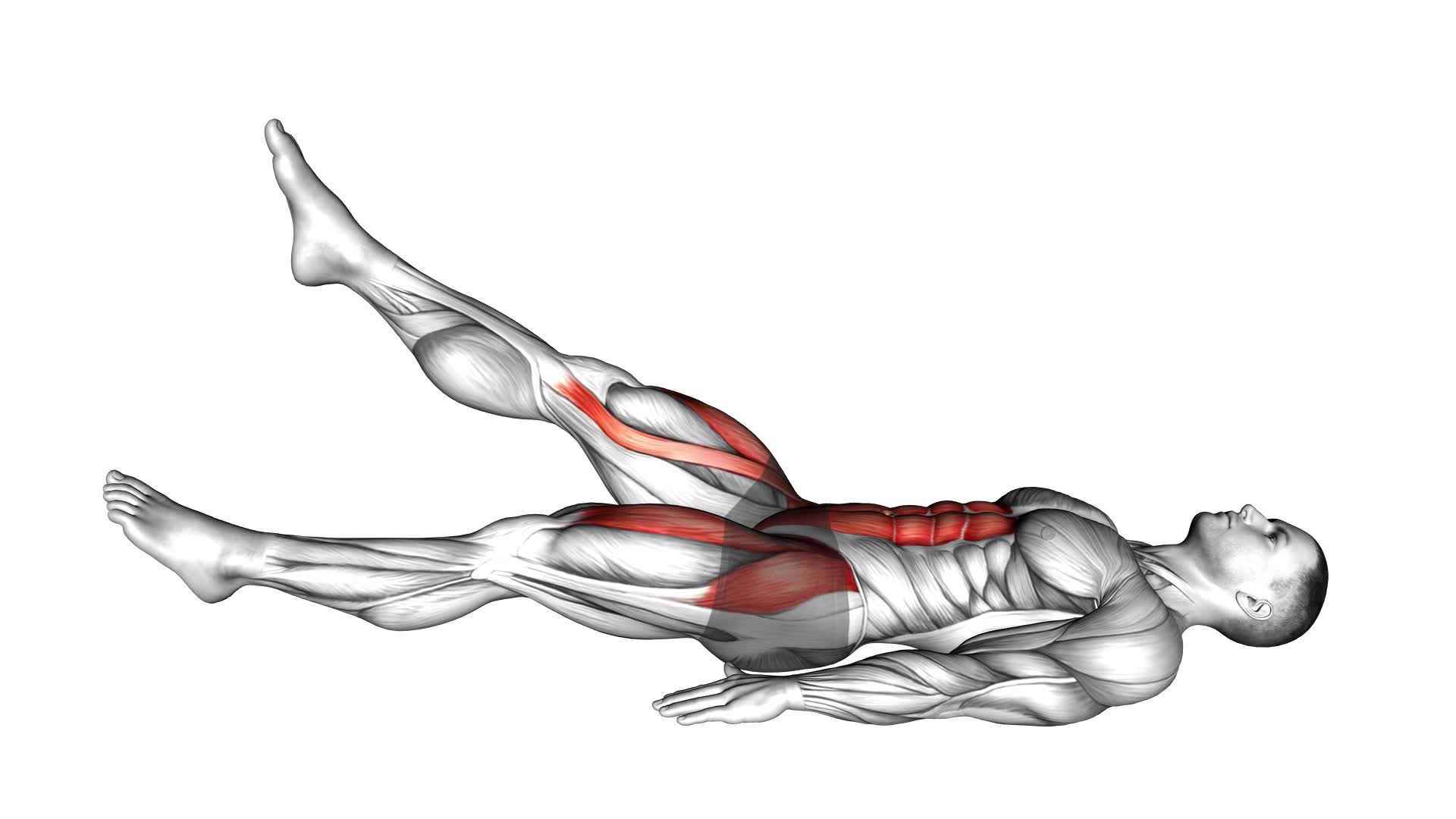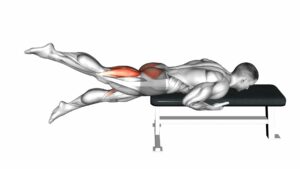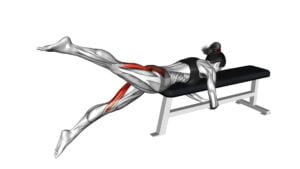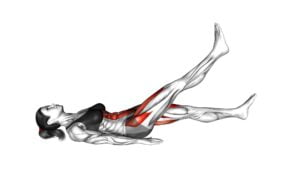Flutter Kicks (version 3) – Video Exercise Guide & Tips

Are you looking for a dynamic exercise to strengthen your core and lower body? Look no further than flutter kicks!
Watch This Exercise Video
In this video exercise guide, we'll show you proper form and technique, variations for increased difficulty, and tips to avoid common mistakes.
Whether you're a beginner or a fitness enthusiast, incorporating flutter kicks into your workout routine will help you achieve a stronger and more toned physique.
Let's get started!
Key Takeaways
- Flutter kicks strengthen abdominal muscles, lower back, and hip flexors.
- Proper form and technique include lying on your back with legs lifted six inches off the ground and using your abdominal muscles to perform the kicks.
- Variations for increased difficulty include weighted flutter kicks, scissor kicks, and flutter kicks on an unstable surface.
- To avoid common mistakes, engage your core muscles, maintain a steady pace, keep your legs straight, and breathe rhythmically.
Benefits of Flutter Kicks
Discover the numerous benefits you can experience through incorporating flutter kicks into your exercise routine.
Flutter kicks aren't only an effective exercise for your core strength but also for leg endurance. By engaging your core muscles, flutter kicks help to strengthen your abdominal muscles, lower back, and hip flexors. This increased core strength can improve your overall stability and balance during other exercises and everyday activities.
Additionally, flutter kicks target your leg muscles, including the quadriceps, hamstrings, and calf muscles, which can help improve leg endurance and stamina.
Incorporating flutter kicks into your routine can also help improve your cardiovascular fitness. The continuous movement of flutter kicks raises your heart rate, increasing blood flow and oxygen delivery to your muscles. This can enhance your endurance and stamina, allowing you to perform better in other cardiovascular activities such as running or cycling.
Furthermore, flutter kicks can be a great addition to any weight loss or toning program. The combination of engaging multiple muscle groups and raising your heart rate can help burn calories and contribute to overall fat loss. The repetitive nature of the exercise also helps to tone and sculpt your leg muscles, giving them a more defined and lean appearance.
In conclusion, incorporating flutter kicks into your exercise routine can provide numerous benefits, including improved core strength, leg endurance, cardiovascular fitness, and enhanced weight loss and toning.
Proper Form and Technique
To perform flutter kicks with proper form and technique, you should maintain a steady and controlled rhythm while engaging your core muscles.
Start by lying on your back with your arms at your sides and legs extended. Lift your legs about six inches off the ground and begin alternating kicks, as if you were swimming.
It's important to keep your lower back pressed into the ground and avoid any excessive arching. This will ensure you're effectively engaging your core muscles throughout the exercise.
Another common mistake to avoid is using momentum to swing your legs rather than relying on your abdominal muscles. Remember to breathe steadily and maintain a controlled pace.
Flutter kicks can be a great addition to your workout routine as they target your lower abs, hip flexors, and quads.
Now that you have mastered the proper form and technique, let's explore some variations for increased difficulty.
Variations for Increased Difficulty
To increase the difficulty of flutter kicks, you can incorporate variations that challenge your core muscles even more. These advanced modifications will help maximize muscle activation and take your workout to the next level.
One variation you can try is the weighted flutter kick. Simply hold a dumbbell or medicine ball in your hands while performing the exercise. The added resistance will increase the intensity and engage your core muscles even more.
Another option is the scissor kick. Instead of keeping your legs straight, bend your knees slightly and perform a scissor-like motion with your legs. This modification targets your lower abs and hip flexors, providing an extra challenge.
If you're looking for an even more advanced variation, you can try the flutter kick progression. Start with regular flutter kicks, then move on to performing them on an unstable surface, such as a stability ball. This will require more core stability and control, further activating your muscles.
Incorporating these advanced modifications into your flutter kick routine won't only increase the difficulty, but also enhance muscle activation. Remember to maintain proper form and technique throughout the exercises to avoid injury. Push yourself and enjoy the challenge!
Tips for Avoiding Common Mistakes
To ensure proper form and prevent potential injuries, it's important for you to be mindful of some common mistakes while performing flutter kicks. Here are some tips to help you avoid these common mistakes and execute the exercise correctly:
- Engage your core: Make sure to keep your core muscles engaged throughout the movement. This will help you maintain stability and prevent strain on your lower back.
- Maintain a steady pace: Avoid rushing through the exercise and maintain a steady pace. Flutter kicks should be performed with controlled and deliberate movements.
- Keep your legs straight: It's important to keep your legs straight throughout the exercise. Avoid bending your knees or lifting your legs too high, as this can put unnecessary strain on your hip flexors.
- Breathe rhythmically: Remember to breathe rhythmically throughout the exercise. Inhale as you lower your legs and exhale as you raise them. This will help you maintain a steady rhythm and prevent breath-holding.
Incorporating Flutter Kicks Into Your Workout Routine
To incorporate flutter kicks into your workout routine, consider adding them as a dynamic core exercise. Flutter kicks can be incorporated into a HIIT (High-Intensity Interval Training) workout in various ways to enhance your core strength and stability.
One way to incorporate flutter kicks into a HIIT workout is by performing them as a standalone exercise. Begin by lying on your back with your legs extended and your hands placed under your glutes for support. Lift your legs a few inches off the ground and start kicking them up and down in a quick and controlled motion. Aim for a high number of repetitions, such as 30-60 seconds, before moving on to the next exercise in your HIIT circuit.
Another way to incorporate flutter kicks is by combining them with other core exercises. For example, you can alternate between flutter kicks and exercises like planks, Russian twists, or mountain climbers. This will keep your core engaged throughout the entire workout and provide a challenge for your muscles.
Incorporating flutter kicks into your HIIT routine can help improve your core strength and stability. By targeting the lower abs, hip flexors, and lower back muscles, flutter kicks help to strengthen and tone your core. Additionally, the constant movement and activation of the core muscles during flutter kicks can improve your overall stability and balance.
Frequently Asked Questions
How Many Calories Can You Burn by Doing Flutter Kicks?
When it comes to burning calories, flutter kicks can be an effective exercise. They target your core muscles and can help strengthen them.
Incorporating variations of flutter kicks into your HIIT workout routine can make it more challenging and increase calorie burn.
Can Flutter Kicks Help in Reducing Belly Fat?
Flutter kicks can be effective in reducing belly fat by strengthening and toning the abdominal muscles. By incorporating flutter kicks into your full body workout routine, you can target your core and increase overall abdominal strength.
This exercise engages multiple muscle groups, helping to burn calories and promote fat loss. However, it's important to remember that spot reduction isn't possible, so combining flutter kicks with a balanced diet and regular cardio exercise will yield the best results for reducing belly fat.
Is It Necessary to Have a Mat or Any Equipment to Perform Flutter Kicks?
You don't need a mat or any equipment to perform flutter kicks. They can be done on any flat surface, like the floor or a yoga mat, but it's not necessary.
However, if you prefer extra comfort or support, you can use a mat.
Flutter kicks are a great exercise to add to your workout routine because they target your core muscles and can help improve your overall fitness level.
Plus, there are alternatives to flutter kicks if you're looking for variety in your workouts.
Can Flutter Kicks Be Done by Beginners or Is It Suitable Only for Advanced Fitness Levels?
Flutter kicks can be done by beginners as well as advanced fitness levels. They're a versatile exercise that can be modified to suit different fitness levels. Beginners can start by performing flutter kicks with proper form and gradually increase the intensity as they get stronger.
The benefits of flutter kicks for beginners include strengthening the core, improving hip flexor strength, and increasing overall endurance. So, don't hesitate to give flutter kicks a try, regardless of your fitness level.
Are There Any Specific Breathing Techniques to Follow While Doing Flutter Kicks?
When doing flutter kicks, it's important to focus on your breathing to maintain proper form. Take a deep breath in as you lift your legs off the ground, and exhale as you lower them down. This controlled breathing helps engage your core muscles and supports your movement.
Conclusion
In conclusion, Flutter kicks are a great exercise for targeting your core muscles and improving overall strength and stability.
By maintaining proper form and technique, you can maximize the benefits of this exercise and avoid common mistakes.
Additionally, incorporating variations into your routine can help increase the difficulty and challenge your muscles even further.
So, add Flutter kicks to your workout routine and enjoy the results.

Author
Years ago, the spark of my life’s passion ignited in my mind the moment I stepped into the local gym for the first time. The inaugural bead of perspiration, the initial endeavor, the very first surge of endorphins, and a sense of pride that washed over me post-workout marked the beginning of my deep-seated interest in strength sports, fitness, and sports nutrition. This very curiosity blossomed rapidly into a profound fascination, propelling me to earn a Master’s degree in Physical Education from the Academy of Physical Education in Krakow, followed by a Sports Manager diploma from the Jagiellonian University. My journey of growth led me to gain more specialized qualifications, such as being a certified personal trainer with a focus on sports dietetics, a lifeguard, and an instructor for wellness and corrective gymnastics. Theoretical knowledge paired seamlessly with practical experience, reinforcing my belief that the transformation of individuals under my guidance was also a reflection of my personal growth. This belief holds true even today. Each day, I strive to push the boundaries and explore new realms. These realms gently elevate me to greater heights. The unique combination of passion for my field and the continuous quest for growth fuels my drive to break new ground.







